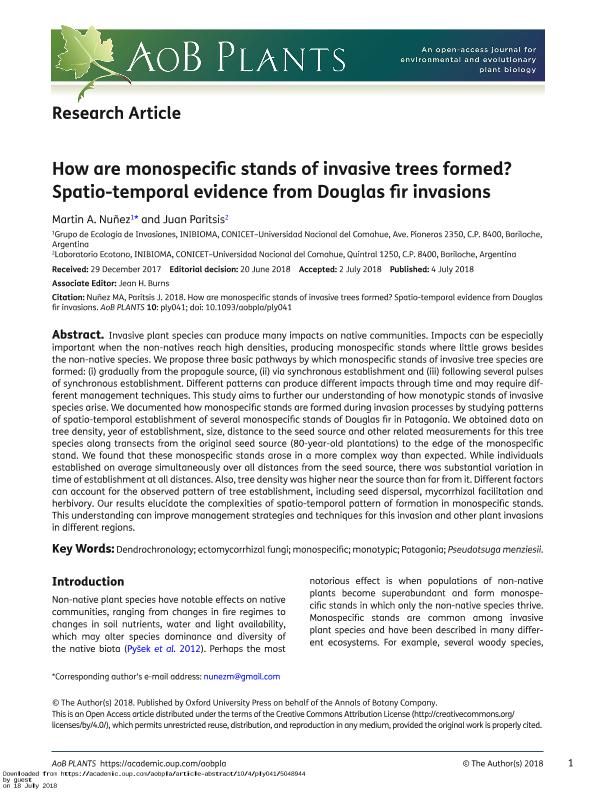Mostrar el registro sencillo del ítem
dc.contributor.author
Nuñez, Martin Andres

dc.contributor.author
Paritsis, Juan

dc.date.available
2019-11-26T21:22:17Z
dc.date.issued
2018-07-04
dc.identifier.citation
Nuñez, Martin Andres; Paritsis, Juan; How are monospecific stands of invasive trees formed? Spatio-temporal evidence from Douglas fir invasions; Oxford University Press; AoB PLANTS; 10; 4; 4-7-2018; 1-10
dc.identifier.issn
2041-2851
dc.identifier.uri
http://hdl.handle.net/11336/90596
dc.description.abstract
Invasive plant species can produce many impacts on native communities. Impacts can be especially important when the non-natives reach high densities, producing monospecific stands where little grows besides the non-native species. We propose three basic pathways by which monospecific stands of invasive tree species are formed: (i) gradually from the propagule source, (ii) via synchronous establishment and (iii) following several pulses of synchronous establishment. Different patterns can produce different impacts through time and may require different management techniques. This study aims to further our understanding of how monotypic stands of invasive species arise. We documented how monospecific stands are formed during invasion processes by studying patterns of spatio-temporal establishment of several monospecific stands of Douglas fir in Patagonia. We obtained data on tree density, year of establishment, size, distance to the seed source and other related measurements for this tree species along transects from the original seed source (80-year-old plantations) to the edge of the monospecific stand. We found that these monospecific stands arose in a more complex way than expected. While individuals established on average simultaneously over all distances from the seed source, there was substantial variation in time of establishment at all distances. Also, tree density was higher near the source than far from it. Different factors can account for the observed pattern of tree establishment, including seed dispersal, mycorrhizal facilitation and herbivory. Our results elucidate the complexities of spatio-temporal pattern of formation in monospecific stands. This understanding can improve management strategies and techniques for this invasion and other plant invasions in different regions.
dc.format
application/pdf
dc.language.iso
eng
dc.publisher
Oxford University Press

dc.rights
info:eu-repo/semantics/openAccess
dc.rights.uri
https://creativecommons.org/licenses/by/2.5/ar/
dc.subject
DENDROCHRONOLOGY
dc.subject
ECTOMYCORRHIZAL FUNGI
dc.subject
MONOSPECIFIC
dc.subject
MONOTYPIC
dc.subject
PATAGONIA
dc.subject
PSEUDOTSUGA MENZIESII
dc.subject.classification
Ecología

dc.subject.classification
Ciencias Biológicas

dc.subject.classification
CIENCIAS NATURALES Y EXACTAS

dc.title
How are monospecific stands of invasive trees formed? Spatio-temporal evidence from Douglas fir invasions
dc.type
info:eu-repo/semantics/article
dc.type
info:ar-repo/semantics/artículo
dc.type
info:eu-repo/semantics/publishedVersion
dc.date.updated
2019-10-10T13:54:09Z
dc.journal.volume
10
dc.journal.number
4
dc.journal.pagination
1-10
dc.journal.pais
Reino Unido

dc.journal.ciudad
Londres
dc.description.fil
Fil: Nuñez, Martin Andres. Consejo Nacional de Investigaciones Científicas y Técnicas. Centro Científico Tecnológico Conicet - Patagonia Norte. Instituto de Investigaciones en Biodiversidad y Medioambiente. Universidad Nacional del Comahue. Centro Regional Universidad Bariloche. Instituto de Investigaciones en Biodiversidad y Medioambiente; Argentina
dc.description.fil
Fil: Paritsis, Juan. Consejo Nacional de Investigaciones Científicas y Técnicas. Centro Científico Tecnológico Conicet - Patagonia Norte. Instituto de Investigaciones en Biodiversidad y Medioambiente. Universidad Nacional del Comahue. Centro Regional Universidad Bariloche. Instituto de Investigaciones en Biodiversidad y Medioambiente; Argentina
dc.journal.title
AoB PLANTS
dc.relation.alternativeid
info:eu-repo/semantics/altIdentifier/url/https://academic.oup.com/aobpla/article/10/4/ply041/5048944?searchresult=1
dc.relation.alternativeid
info:eu-repo/semantics/altIdentifier/doi/http://dx.doi.org/10.1093/aobpla/ply041
Archivos asociados
